Are We in an Airship Renaissance?
One hundred years after the first U.S. Navy airship took to the skies, zeppelins and blimps are poised to make a comeback
:focal(500x376:501x377)/https://tf-cmsv2-smithsonianmag-media.s3.amazonaws.com/filer_public/62/f2/62f24db9-7f1f-4ab1-b2c5-4bd5c645bd60/21g_fall2023_airshipsshenandoah100-shen_c517ac454ab72_002_live.jpg)
At 6:50 pm on September 4, 1923, the first American-built rigid airship took to the skies. The U.S. Navy had designated the 680-foot-long zeppelin ZR-1. A month later, it would be formally christened the USS Shenandoah. But that day, newspapers dubbed the vehicle “Leviathan of the Air.”
Front-page photos captured the scene: 250 men clutching ropes, slowly dragging the silver airship from the vast dark maw of Hangar No. 1 at New Jersey’s Lakehurst Naval Air Station. Engineers had spent seven months in the 224-foot-high hangar assembling parts that had been fabricated at the Naval Aircraft Factory in Philadelphia. The design for ZR-1 had been reverse-engineered from a German airship forced down in 1917 after dropping 4,600 pounds of bombs on targets in Great Britain.
Images of the airship passing through the 1,350-ton steel doors of the hangar evoke another scene: when NASA’s Saturn V rocket slowly emerged from the Kennedy Space Center’s Vehicle Assembly Building in the late 1960s—the first leg of its long trip to the moon. Both moments heralded a new era of flight aboard colossal craft that loomed over their Lilliputian builders. And, like the rockets that would carry U.S. astronauts into space, the USS Shenandoah and the growing fleet of U.S. airships owed their existence to weapons of terror developed by German engineers when the world was at war.
Similar to the Saturn V, the builders of the first American zeppelin (“The Mightiest Ship of the Air!” proclaimed newspapers) had big dreams for their creation. The Navy envisioned a fleet of commercial airships that, like merchant marine vessels, would form a reserve force that could be mobilized to defend the country. Some believed the airships would completely revolutionize warfare. “The ZR-1 is the forerunner of the great airplane carriers of the future, those mother birds that will convey flocks of steel-beaked fliers armed with huge bombs capable of destroying battleships, forts, and encampments,” declared an editorial in the Maine-based Kennebec Journal. At one point, the Navy even planned to send the ZR-1 on an expedition to the North Pole.
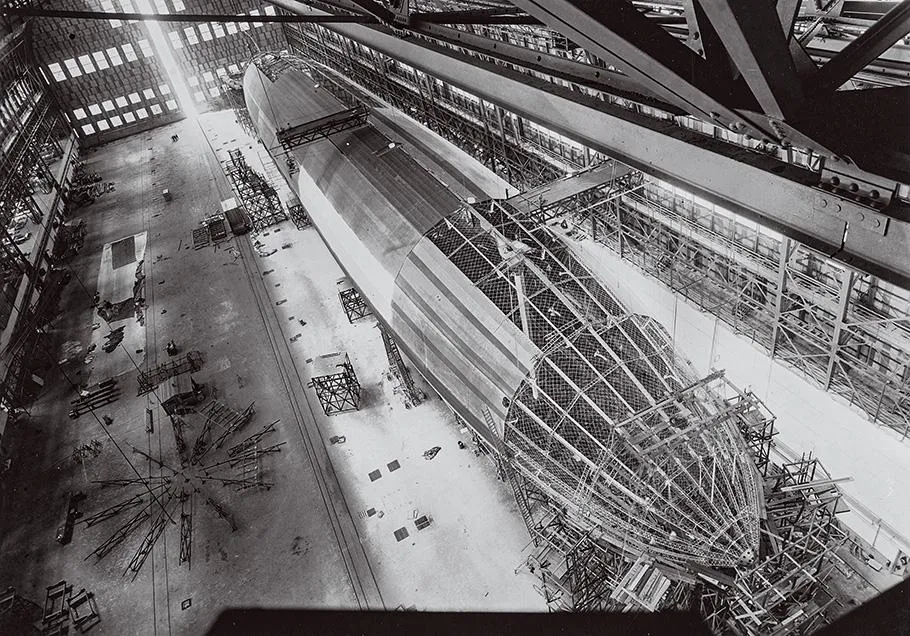
But while the Saturn V would fulfill its promise of opening a new chapter of exploration, the airships would have a less illustrious destiny. To be sure, the lighter-than-air behemoths enjoyed moments of glory—most famously as aerial cruise ships outfitted with dining halls, cabins, and observation decks. Indeed, these early airships offered a luxury experience in the air that would be unmatched for decades.
Unfortunately, with the airships’ huge size came massive maintenance and refueling expenses, not to mention ground crews the size of small armies to handle landings and moorings. Safety became a growing concern: The lightweight construction materials made airships vulnerable to high winds and thunderstorms. The USS Shenandoah crashed in 1925, followed by the USS Akron in 1933 and the USS Macon in 1935. Meanwhile, as aviation technology continued to progress, airplanes ultimately proved they could get the job done faster and cheaper. The catastrophic failure of the Hindenburg in 1937 destroyed the market for airships as passenger-carrying transports, leaving them to eke out an existence as mostly niche aircraft (think Goodyear Blimp).
But after nearly a century in exile, airships seem poised to make a comeback, thanks to a new generation of engineers who are enamored with the golden age of lighter-than-air vessels and see their potential. By using electric propulsion systems powered by solar panels and hydrogen fuel cells, airships could help the aviation industry significantly reduce carbon dioxide emissions. Airships could also play an important role in delivering humanitarian aid to places that have been devastated by natural disaster, since they don’t require infrastructure such as airstrips. And, airships are no longer quite so fragile: The era of cotton and aluminum has given way to carbon-fiber tubes and fire-resistant synthetic fabrics.
Engineers are contemplating airships in myriad forms. They can choose from zeppelins, which have an internal metal framework; blimps, which are essentially oversized balloons; and semi-rigid, which are blimps that have a metal keel extending along their base. Familiar concepts from previous decades are being dusted off and adapted to our own era. For the first time in nearly 100 years, a new generation of giant rigid airships is currently undergoing flight testing at Moffett Field in Mountain View, California, by LTA Research and Exploration, a company founded in 2016 by Google co-founder Sergey Brin. The company’s proof-of-concept, 400-foot rigid airship is called Pathfinder 1.
Elsewhere in the world, other airship startups are under way. Russian engineers are building on a Soviet-era design for an airship in the shape of a flying saucer. Proposals are being drawn up to deploy airships for transporting hydrogen from one coast of Australia to the other. Flying Whales, a company backed by the French government, has just announced another $137 million of funding and has started construction of the assembly line for its LCA60T rigid airship. Israel-based Atlas has built and sold airships—12 blimps in total—and work has already begun on founder Gennadiy Verba’s latest design, an all-electric sightseeing blimp. The British company Hybrid Air Vehicles—whose Airlander 10 design is capable of transporting up to 100 on short-haul journeys—announced last year that the Spanish Air Nostrum Group had reserved 10 airships to fly on its regional routes.
“The problem with American big-rigid design during the 1920s and ’30s is that the technology didn’t match the dreams of their promoters,” says John J. Geoghegan, author of When Giants Ruled the Sky. “The materials used were not strong enough, and there was not a sufficient understanding of the aerodynamic forces that acted upon an airship in flight. This meant these big rigids were not robust enough to survive the weather conditions they encountered. Now, that has all changed.”
War and Peace
The airship industry in the United States can trace its beginnings to October 20, 1917, when a German zeppelin, L-49,was forced to land at Bourbonne-les-Bains, where it was captured by French forces. “Efforts of the crew to fire the ship on landing were frustrated and the recovery of the ship’s structure almost intact provided the source of much valuable design information for the Allies, and ourselves, for French engineers, with great thoroughness, carefully measured and recorded dimensions of each part,” concluded an assessment by the U.S. Navy.

Lieutenant Commander Zachary Lansdowne was a visionary who saw the potential of lighter-than-air (LTA) aviation for the U.S. Navy. In October 1924, Lansdowne achieved one of the greatest feats of the golden age of the airship when he flew the Shenandoah on a 19-day, 235-flight-hour journey across the U.S. from Lakehurst to San Diego, up the West Coast to Seattle, and back. Americans were in awe of the flying colossus.
But just 11 months later, on September 3, 1925, after a remarkable 56 flights, the Shenandoah got caught in a storm over Ohio and broke in two. Fourteen men out of 21 died in the crash.
The Navy had done an impressive job reverse engineering the L-49, but therein was the problem. The German airship was a “height climber,” a class of advanced, high-altitude airships designed to fly too high to be shot down by enemy fighters and anti-aircraft guns. As such, the L-49’s metal skeleton had been lightened—and weakened—to enable the giant bomber to reach 25,000 feet, a fact that should have eliminated the design as a peacetime airship. “The German pilots had figured out that to survive they needed to slow down in the gusty air, almost completely coming to a stop to reduce the impact of the wind,” says Alan Weston, CEO of LTA Research and Exploration. “The American pilots didn’t know that.”
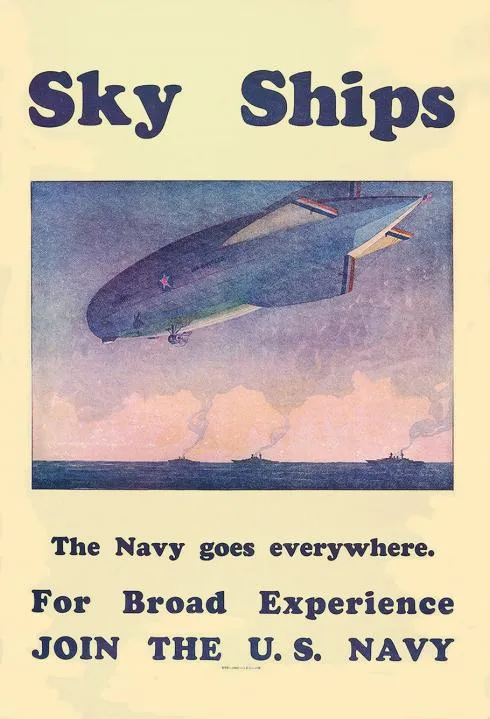
For Ron Hochstetler, a retired airship consultant, the Shenandoah crash represents many of the challenges he faced in airship development during his career. “The Shenandoah’s creators had little experience with its delicate design,” he says. “Or with the limitations of the new materials that the ship incorporated.” Too little time and resources were given to understanding the operational limits of the design, and too much performance was expected from such an untried vehicle concept. “Yet its owners, builders, and flight crews invested extravagant amounts of faith and hope for its success only to have these dashed to pieces on the farmland of Ohio,” says Hochstetler.
Tragically, there was evidence that the Shenandoah’s crew had eschewed the cautious approach adopted by wartime German zeppelin pilots. One Navy lieutenant even bragged to a newspaper about his battles against the elements and his “thrilling races” with clouds and near brushes with death. “We had just cleared the gap through the Rocky Mountains when I saw a dim cloud dead ahead, too close for us to miss it,” he recalled. “We began shooting down like a plummet when the powerful down currents caught us. When we hit the cloud, we were more than 2,000 feet up. When we emerged from the storm, we were less than 300 feet from the ground, because our wireless antennae, which hangs from the cabin, had been wiped off.”
Rather than foreshadowing disaster, newspapers reported such stories as confirmation that U.S. airships could endure even the worst conditions as long as capable men were at the helm. And, despite the Shenandoah’s demise, America’s love affair with rigid airships continued to grow with the building of the monumental Goodyear Airdock (now called the Akron Airdock) in Akron, Ohio, and the construction of even larger airships—the USS Akron and USS Macon—in the early 1930s. Still, the Americans continued to fly their rigid airships more aggressively than the Germans, and the Akron and the Macon both crashed during storms. In contrast, the German zeppelins flew for around 19 years without a single fatality until the loss of the Hindenburg.
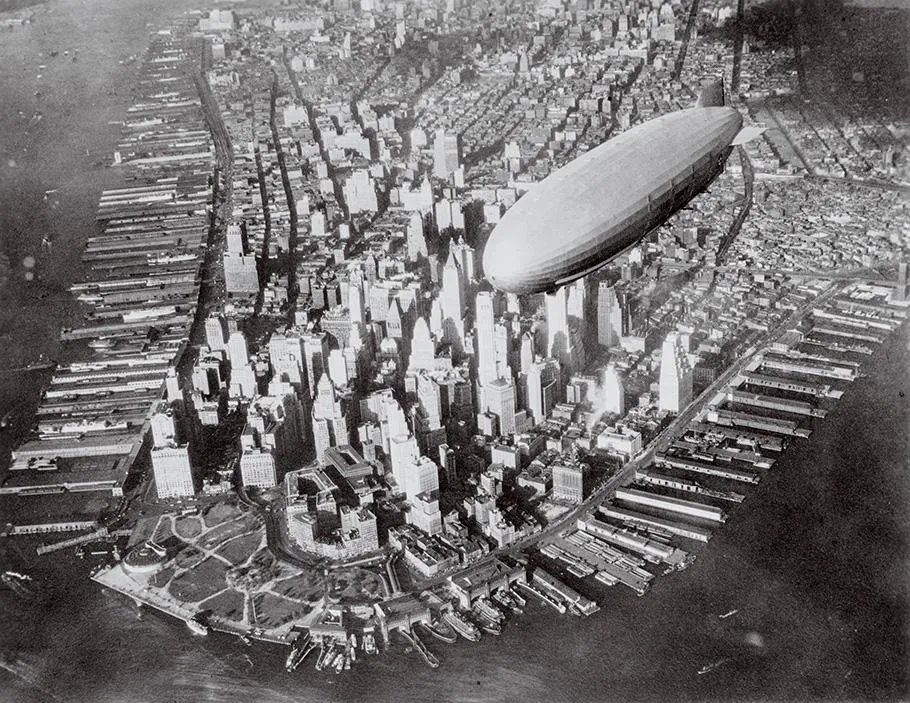
It’s understandable then, that today’s lighter-than-air pioneers have a bittersweet feeling toward the squandered opportunities of the past. They are hoping that this time hubris and haste don’t doom the airship a second time—just as low-carbon transportation technologies are needed most. “The rigid airships were the most extraordinary vehicles ever flown,” says Weston. “There were failures and great successes. It’s tragic that simple screw-ups like this doomed airships in the U.S.”
Weston and other modern-day pioneers are determined not to repeat the same mistakes. “We all devour any old airship memorabilia we can find, but the technological advances over the last 100 years mean that we are really doing something completely new,” says mechanical engineer Jillian Hilenski, who is working on the Pathfinder. “We’re entirely redesigning components and using carbon fiber tubes and titanium joints to make up the skeleton of the ship. That alone is such a huge innovation compared to the 1930s that it almost doesn’t seem we are comparing apples with apples anymore.”
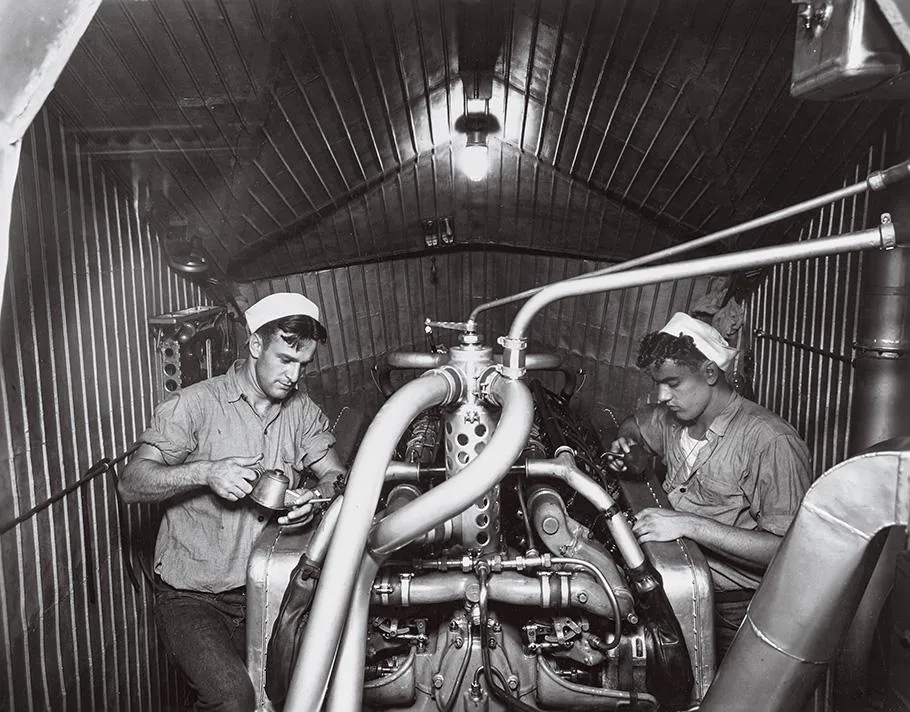
Hochstetler’s dream of lighter-than-air flight began when, as a university student, he saw the Goodyear Blimp lit up at night on a local airfield where it was overnighting. “I was struck that airships were like clouds and belong in the sky, that they don’t have to scramble their way into the air like a jet or fall to the earth if they don’t keep going,” he says. “It was marvelous, and it totally intrigued me.”
Hochstetler’s first project was the Piasecki PA-97 Helistat. Built for the U.S. Forest Service, it was an experimental heavy-lift airship designed to carry timber from difficult terrain. Propulsion was provided by four Sikorsky H-34J helicopters attached with scaffolding to the bottom of the large helium-filled envelope, a retired Navy ZPG-2W blimp. “When I walked into the hangar that the Helistat was being assembled in, I was overwhelmed with the thrill of seeing a great big real airship for the first time,” Hochstetler recalls. “I was so excited to be part of what I believed was the renaissance of the giant airship age. But I also discovered I was the only person on that project who held this conviction. In time I began to understand the reason for my coworkers’ cynicism. The project was being done on the cheap. And consequently, it wasn’t likely to result in an exemplary aircraft. In fact, the other assemblers referred to the Helistat as the ‘Hindentitanic.’ ” The name proved to be prophetic. On July 1, 1986, after lifting off on a test flight, the prototype crashed, killing one of its pilots.
“Realizing that the Helistat project was not likely to end well, I decided to leave the company in May of 1985,” says Hochstetler. “When I heard about the crash and the death of one of the pilots, I was shocked and saddened, but not surprised.”
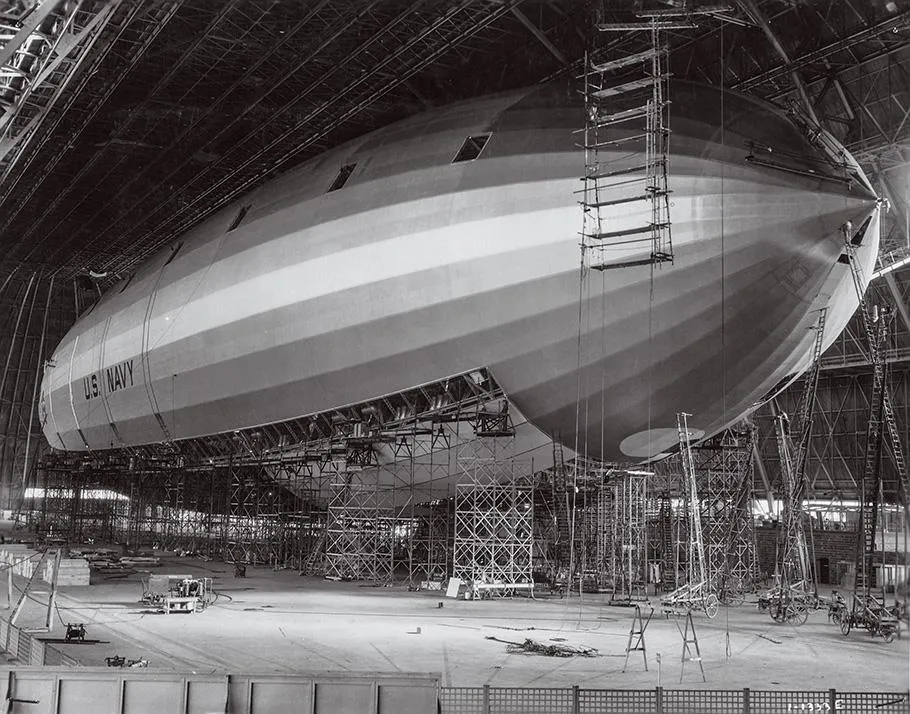
Hochstetler also worked on the now-infamous Cargolifter AG project, wherein a German company in the 1990s sought to build a gigantic airship, the CL 160, which would be equipped with a massive crane capable of carrying 160 metric tons. The company declared insolvency in 2002 after burning through $250 million worth of investments. Cargolifter failed because the challenges of building such a complex ship were underestimated by its promoters. A hangar was built for the planned airship. The largest freestanding hangar in the world, it is now a holiday resort featuring an indoor rainforest. The epic failure of the CL 160 still haunts the airship industry and engineers.
“It didn’t take me that long to realize that the reality of working in lighter-than-air was very different,” says Hochstetler. “I quickly found that there wasn’t a lot of romance and there wasn’t a lot of money.”
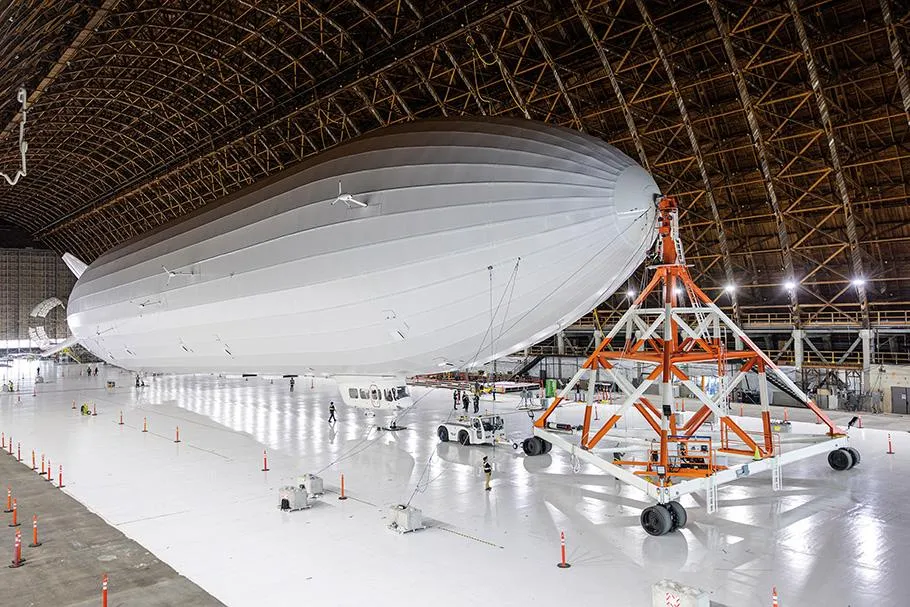
Staying Aloft
LTA Research’s Alan Weston had long been interested in the potential for airships to be more fuel efficient than any other form of aviation. Now, it’s their potential for aiding humanitarian relief that really excites him. “I grew up in Tanzania, Dar es Salaam, and Zambia, and I know roads are terrible in many parts of the world,” he says.
Bathed in light within its huge hangar, LTA’s Pathfinder 1 looks more like a spaceship than an airship. The company recently conducted a test flight inside LTA’s giant hangar at California’s Moffett Field, a duplicate of the Akron Airdock (which the company also now owns) originally built to house the USS Macon. Says Weston: “There is not enough space to turn around or do a loop-the-loop, but we can go up and down, sideways, and forwards and backwards to test our primary functionality—and do it tethered so it can’t hurt anything.” LTA is now preparing to conduct extensive outdoor testing.
The materials used to construct Pathfinder 1 showcase how 21st-century technology is being applied to 20th-century designs. The outer covering is flame-retardant and made of multiple layers of synthetic materials. As a safety measure, lidar sensors constantly monitor the helium in the gas cells. If there’s a volume change, the lidar helps indicate if it’s due to changes in elevation or temperature—or caused by a significant gas leak. Twelve electric motors lining the sides and tail of the airship can be rotated 180 degrees for vertical liftoff and directional control.
The workers who constructed airships like the Macon had to climb tall, swaying ladders. Today, a cradle-like apparatus (nicknamed the Roller Coaster) slowly rotates the giant airframe on its horizontal axis, enabling workers to remain safely on the ground.
And yet, both investors and potential investors have been frustrated by what they perceive as the slow pace to launch the modern airship industry. “They seem to think that airships are in some way easy because they see these things bobbing around in the sky flying quite slowly,” says Mike Durham, chief technical officer at Hybrid Air Vehicles. As such, “there are still a lot of businesses in the lighter-than-air world that pop up, work from a garage or a garden shed for a few years, make all sorts of claims on the web about how great their product is, and then disappear,” says Durham. “The airship world has been tainted somewhat by those types of businesses.”
Initially, Atlas’ Gennadiy Verba was one of these people. “I did mistakenly think that airships were a very simple technology,” he says. “I couldn’t understand why this kind of aircraft that’s very easy to build was not everywhere.” The end of Cargolifter, for example, hit him hard because it was a large project that had received a substantial amount of funding. “Its failure created a lot of doubts among investors about airships and the possibility of implementing this technology,” says Verba.


The veterans of the lighter-than-air industry have a long list of lessons learned from such failed and cancelled projects. The bullet points include an understanding of the history of the airship and its complexity; prioritization of teamwork over charismatic leaders; designing aircraft that can be mass produced; and, finally, an effective method of controlling buoyancy on the ground, vital for heavy-lift airships. And then there’s an underlying conundrum: The potential customers for this new generation of airships are not always prepared to pay for their development. What’s an airship company to do?
Sébastien Bougon, founder of the French company Flying Whales, is taking a very different approach—a very French, state-backed approach—to building the next generation of airships. “Americans like to go straight to building an airship or a rocket,” he says. “In France, we prefer the Airbus approach of step by step, working hand in hand with the regulator, because airships make people very nervous here, even though we invented them.”
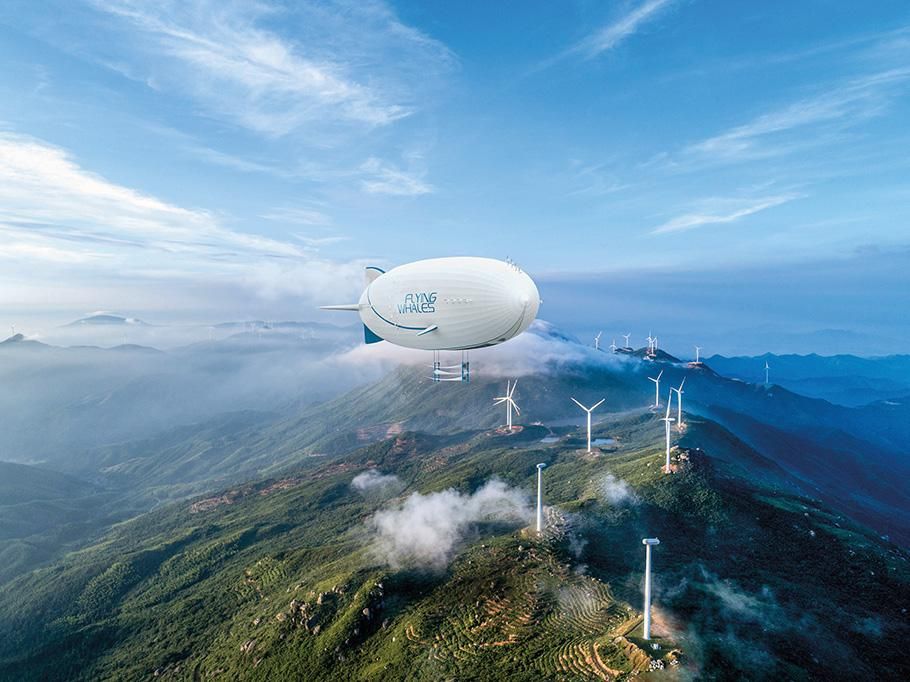
Bougon’s vision of a rigid airship for heavy-lift transport came over dinner with the CEO of the National Forest Agency in France, who was struggling to transport enough logs out of remote regions of southern France. They approached the National Aerospace Agency, which agreed to support their idea. One year of preliminary studies moved into a four-year “de-risking phase,” when the French government and a consortium of French companies looked at more than 100 airship projects, including Cargolifter, to understand why they failed, as well as studying 12 different shapes.
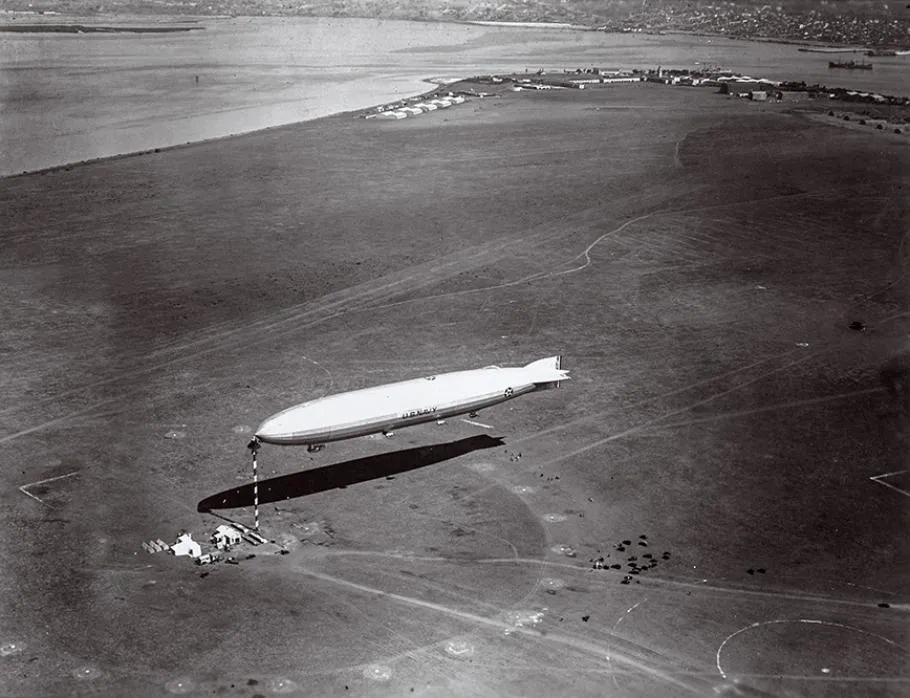
“We were design agnostic, but there are too many people in the industry who think they have the solution,” says Bougon. “They tell me we must make a blimp. Others, that it should be a rigid airship. Some, a deltoid shape. Okay, so let’s study them all. In the end, we decided on the same as previous centuries, a rigid airship.” A manufacturing line is being prepared near Bordeaux, with plans to ultimately produce 160 units.
Ultimately, it’s the success or failure of companies like Flying Whales and LTA that will determine whether these mammoth craft will once again be seen in the skies. Airships never cease to inspire wonder, and they resonate with those who yearn for more stately modes of transportation. Says Hochstetler: “It is a dream that has bitten so many people.”
Mark Piesing is an aviation journalist and the author of N-4 Down: The Hunt for the Arctic Airship Italia (Custom House, 2021).
Check out the interactive history of the USS Shenandoah.
This article is from the Fall issue of Air & Space Quarterly, the National Air and Space Museum's signature magazine that explores topics in aviation and space, from the earliest moments of flight to today. Explore the full issue.
Want to receive ad-free hard-copies of Air & Space Quarterly? Join the Museum's National Air and Space Society to subscribe.
